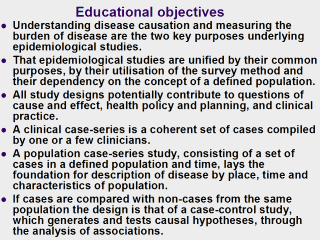 |
- A cross-sectional study measures disease and risk factor prevalence in
a sample of individuals in a population in a defined time period, mainly
to explore the burden of disease but also to generate associations.
- A cohort study consists of a sample of individuals in a population
followed up over time to observe changes in health status, to measure
disease incidence, and to examine associations between risk factors and
health outcomes.
- A trial is similar in design to a cohort study except that the
investigators impose an intervention on one or more of the study
populations.
- The ecological 'design' is really a mode of analysis based on
variables being applied to places rather than individuals, rather than a
design.
- There are conceptual and practical interrelationships between various
study designs.
|
